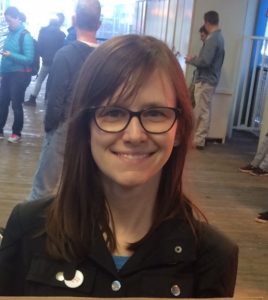 This post was written by Kristin MacDonough, who received a GLAM Cross-Pollinator Fellowship to attend this year’s DLF Forum.
This post was written by Kristin MacDonough, who received a GLAM Cross-Pollinator Fellowship to attend this year’s DLF Forum.
As the Grainger Fellow in Time-Based Media Conservation at the Art Institute of Chicago, Kristin is developing new protocols and procedures for acquiring and preserving time-based media artworks at the museum. Conveniently, her current position is located across the street from her previous job as the Digitization Specialist at the Video Data Bank; her work at VDB was very much informed by her role as a technician in the 2013 exhibition XFR STN at the New Museum of Contemporary Art. A member of the Chicago Area Archivists, she also coordinates the Audiovisual Materials Interest Group within the organization. Kristin is a 2013 graduate of the Moving Image Archiving and Preservation program at New York University, a founding member of XFR Collective, and a past participant of the Audiovisual Preservation Exchange (APEX) program (Colombia 2014 and Uruguay 2015). Outside of work, Kristin organizes training workshops on video preservation, enjoys dog-sitting, and was recently introduced to kayaking.
The DLF Forum was an incredibly welcoming experience. I’m grateful to have had the opportunity to join such a thoughtful and generous community, and thank the organizers and the attendees for building this healthy, welcoming space for sharing knowledge and experience.
In my current position as a conservation fellow for time-based media (TBM) art at the Art Institute of Chicago, I’m working with my colleagues to standardize and improve our workflows for acquisition, documentation, installation, loan, and preservation of TBM artworks. At the Art Institute, we consider as TBM artworks those for which duration is an essential component. This year, we’ve chosen to focus on developing more robust practices for management of the digital elements of TBM art, specifically storage and internal access to artwork files. With these particular goals on my mind, I was fortunate for the opportunity to cross-pollinate with professionals in the library field, where similar projects are taking place, though their concerns of access are wider in scope.
The development of our digital art storage and internal access procedures is a single piece of a larger workflow currently under review. Unsurprisingly, the panels at DLF that attracted my interest the most were those focused on evaluating or establishing workflows, and the essential role that thorough documentation and discussion play in these initiatives. I’ll admit, my eyes crave the winding paths and decision points reminiscent of a choose-your-own-adventure-game, and I love how a well-mapped diagram can clearly articulate actions taken or decisions made which would otherwise remain unspoken. I think that clear, strong workflows–especially those which are interdepartmental in scope–recognize and accommodate the value each stakeholder brings to a process.
Those presentations which focused directly on establishing workflows often went into granular detail to identify the tools used at each step and the way in which these correspond to specific stakeholder responsibilities. Others broadened their inquiry to understand why different departments or collections within a single institution chose dissimilar workflows to accomplish the same tasks, from intake to storage.
All presentations acknowledged the stakeholders, recognizing the work and unique contributions of each person. There is a long-overdue movement across cultural heritage organizations to recognize individual contributions to initiatives, projects, and other ongoing work; this is a welcome change, albeit one that will take time to become standard procedure across all institutions. The first question raised for me is how do we evaluate our progress towards acknowledging individual contribution? And will the measure of that progress necessarily be easily quantifiable?
Developing a workflow is a community building activity: it requires embedding ourselves and our colleagues to certain processes, and understanding how each person contributes to the whole. Community building is, at heart, democratic. How do we keep stakeholders involved in decisions and abreast of the shifting flows of information in order to ensure that every voice–not only the roar of the loudest people in the room–is heard? Can we be diverse and still see ourselves as we and us? Can a workflow be designed and implemented in such a way as to ensure that each person is invested in the whole? Among all of these presentations on workflow review and development, Marisa Duarte’s words regarding the necessity of dissent in a democracy during her opening keynote were also on my mind. Can our whole support the work of all while welcoming contradictory opinions, and embracing a willingness to recognize the gaps in our thinking?
Every institution will have its own means of evaluation. Going forward, I hope to encourage my colleagues to move towards a flexible and open workflow development that acknowledges everyone’s input, including unique perspectives from peripheral stakeholders.
Some presentations which addressed workflows (not a comprehensive list):
- #m1a: From Community Collection to Automated Processing: The Value of Project Management and Workflow Development in Digital Collections (slides and notes);
- #m2a born-digital + portfolios (notes) including: Breaking Down Barriers: Stewardship of Born-digital Materials at Columbia University Special Collections Repositories (slides);
- #m3a content management (notes) including: Collaboration through Analysis: A journey in digital content management workflow analysis (slides);
- #m4c: Digital Humanities and Library Labor: Resources, Workflows, and Project Management in a Collaborative Context (slides and notes)
- #t4a workflows (notes) including: Developing an Orchestration System for Automating Digital Workflows (slides), Construction Zone: Building New Workflows and Communication for an Established Digital Library (slides), Case Management: Or, how we learned to stop worrying and love workflows (slides)
